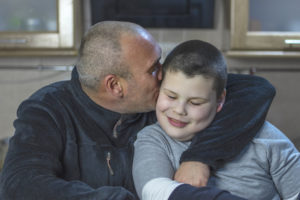Autism is a developmental disorder with many different symptoms and characteristics, so there’s no concrete answer to the question, “What does autism look like?” Every child is different, and the common symptoms of autism spectrum disorder may present differently. That being said, certain behavior patterns are typical among children with autism. These include social and restrictive behavior, speech and language, and sensory problems.
If your child is experiencing these symptoms, have them evaluated and diagnosed by a child psychiatrist or pediatric neurologist. It’s important that your child receives early intervention after receiving a diagnosis. At BlueSprig, we offer treatment programs to help your child reduce problem behaviors and thrive.
Social Behavior
One of the defining characteristics of autism spectrum disorder (ASD) is difficulty with social interactions. This can come across in many ways. Your child may avoid looking at you, or not enjoy interacting with you, or they might dominate conversations on subjects only they are interested in. They may not feel comfortable initiating conversation or picking up on how other people feel.
Other symptoms of social dysfunction include:
- Lack of interest in connecting with others or sharing achievements
- Coming across as aloof or distant
- Difficulty making friends their same age
- Resistance to being touched
Humans are a social species. That’s why social situations can cause people with autism great anxiety – they may have the desire to connect with someone but are unable to do so. It may be hard for people without autism to understand the struggle, but being patient and caring is the best way to make both parties feel comfortable.
Speech and Language
Many children with ASD struggle to express their thoughts and feelings and to communicate with others. Similar to difficulties with social behavior, speech and communication problems can cause a child great frustration.
Symptoms of speech and language difficulties may include:
- Delay in learning how to speak or not speaking at all
- Speaking in an unusual tone or volume
- Repeating words or phrases without the intent to communicate with someone else
- Misunderstanding or not picking up on sarcasm or irony.
Many people with autism struggle to put their thoughts or feelings into words, potentially causing frustration in themselves and others. Early intervention research shows intensive therapy for speech and language problems is crucial. Getting your child the treatment they need when they are young and more adaptable can make the difference in their developing language skills and communicating clearly and appropriately.
BlueSprig offers comprehensive treatment integrating developmental information drawn from speech and language pathology as well as speech therapy for individuals with autism. For more information, call us at (209) 422-3280.
Restrictive Behaviors
Another defining characteristic of autism is restrictive, repetitive behaviors and interests. For many children with autism, this may look like being insistent on sameness, such as completing the same tasks in the exact same order every time. They may feel anxious or frustrated if something breaks their routine. These behaviors can be problematic in everyday life and affect their ability to engage in social and leisure activities.
Children with autism may even become aggressive or engage in dangerous behaviors if they feel anxious about deviating from their routine. Restrictive behaviors vary greatly, but some common examples include:
- Staring at lights or moving objects
- Ritualistic behavior, such as lining up or counting objects or touching objects in a certain order
- Repetitive body movements such as rocking, twirling, or running back and forth
- Repetitive motion with objects, such as spinning a toy or flipping a switch
Sensory Problems
Although sensory problems are not part of autism’s official diagnostic criteria, many children experience sensitivity to outside stimuli, making them feel uncomfortable, anxious, or afraid. Sensory problems include both hyper and hyposensitivity. Symptoms of hypersensitivity in children with autism may look like:
- Disliking bright lights
- Noticing minuscule pieces of dirt, dust, or hair on items
- Being frightened by flashes of light
Symptoms of hyposensitivity include:
- Continually moving their fingers or objects in front of their eyes
- Creating noises to stimulate their hearing, such as dropping heavy objects or opening and shutting doors
- Not noticing a cut, wound, or burn
- Having poor balance and stumbling or bumping into people frequently
Treatment for Children With Autism
Some children experience mild symptoms while others struggle with more severe symptoms. Because every child is unique with their own personality and interests, it’s impossible to give a concrete answer to the question “What does autism look like?”
Although research is still being done and many questions about autism are left unanswered, one fact remains the same: intensive early intervention ABA therapy is one of the best ways for children with autism to learn the skills they need to help instill positive behaviors. At BlueSprig, our goal is to help every child grow safely in a constructive environment.
Our registered behavior technicians work to develop social, emotional, and communication skills in children with autism. To learn more about our treatment offerings, call (209) 422-3280.
